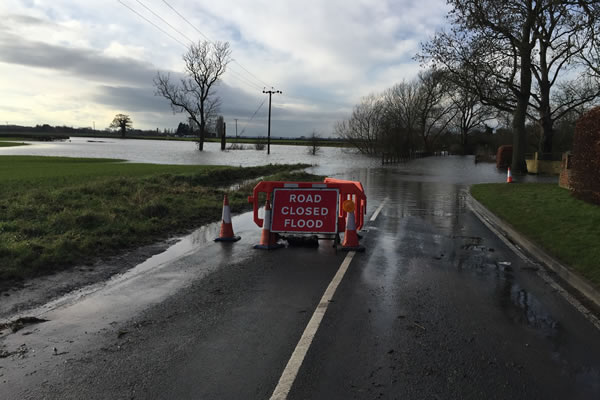Business Continuity
- Approximately 185,000 commercial properties are at risk of Flooding in England and Wales [1]
- Businesses are more likely to be flooded than burnt down
- Cost of fire damage (£7,300) was on average four times less than flood damage [1]
- Some service providers estimate that flooding now accounts for nearly 10% of major business disruptions
- The average losses from a flood are £28,000, compared to £1,033 for a burglary [1]
Summer 2007 Floods
- Over 9,000 businesses were affected [2]
- Cost for flooded businesses averaged between £75,000 and £112,000 [3]
- Cost of damage to infrastructure such as water supplies and power networks was calculated at 660m [3]
- Damage to communications, transport and roads of around £230m, with costs to local councils of £140m, while agriculture suffered losses of £50m [3]
Sources - [1] Environment Agency, [2] BBC, [3] Research commissioned by Environment Agency's Evidence Directorate, January 2010
Is Your Business at risk of Flooding?
Around 5.2 million properties in England, or one in six properties, are at risk of flooding, which includes businesses.
More than 5 million people live and work in 2.4 million properties that are at risk of flooding from rivers or the sea, one million of which are also at risk of surface water flooding.
Your business could be at potential risk of flooding, even if you are not located near a river or the sea, you could be affected by ground water, burst water mains, sewer overflows surface water flooding or a sudden increase in rainfall which exceeds the capacity of the receiving surface water drains
Have you ever thought, how much would this cost to repair? How will it affect my business if it was to ever happen? How much will such an event cost my business in lost sales / revenue?
Sometime the cheaper option is to plan and mitigate against such an event to reduce repair costs, reduce the potential effect on the business, and reduce the potential losses to safeguard the future of your business.
What Types of Flood Risk Could Affect Your Business?
There are different types of flooding which could affect your business dependent upon the location and this is why it’s important to ensure you have sufficiently assessed the potential risk to you by looking at flood risk in a wider perspective to protect your business.
As the Pitt Review noted, following the 2007 floods, climate change is producing more extreme weather patterns and more intense storm events. It is likely that more properties will be hit by surface water (pluvial) flooding over the next 25 years than by 'traditional' river (fluvial) flooding, and most of these will be affected for the first time.
Surface Water (pluvial) Flooding:
This type of flooding is caused because the volume of water falling or flowing onto the ground overwhelms existing drainage systems, such flooding is usually short lived and associated with heavy downpours of rain. Often there is limited advance notice due to the intense nature of rainfall needed to create such flooding. However, weather forecasts can give a good generalised indication of when low probability storm events are likely to occur.
Most highway and development drainage systems are designed to deal with certain frequencies of storm and rainfall intensity. Flooding can be caused by the sheer volume of water or indicate a blockage or maintenance problem within the system. Any flooding should be reported so that the risk can be dealt with and the system checked for adequacy.
Coastal and River (fluvial) Flooding:
Fluvial flooding occurs when rivers overflow and burst their banks due to high or intense rainfall. Coastal flooding is caused by high tides and/or severe weather breaching sea defences and inundating the surrounding areas.
Both of these events can be predicted in advance. Refer to the Environment Agency and Met office website's for flood risk indications and forecasts.
Engineering solutions that can be put in place to mitigate the impact of this type of flooding are limited simply because of the huge volumes of water involved and because it is not contained or channelled.
Groundwater Flooding:
Groundwater flooding is the most problematic type of flooding in many areas. It is different from surface water flooding caused directly by very high levels of rainfall. Where the geology of an area contains held waters there is potential for this to rise and effect areas of the surface, this can also be effected by the surface topography. There is a natural cycle in which the aquifers are filled with rain water in the winter and discharged into chalk streams.
When the aquifers are filled to overflowing in the winter, natural springs and winterbournes are activated (winterbournes are streams or rivers that are dry in the summer months). Exceptional periods of rain can cause groundwater flooding from springs and winterbournes which inundate roads and can overwhelm drainage systems that are not designed to take this additional flow. This type of flooding can last for weeks or months. An early indication of groundwater flooding is often when property cellars start to show water ingress.
Environment Agency, Natural Resources Wales and the Scottish Environment Protection Agency
In England, the Environment Agency is responsible for building, maintaining and operating flood defences and for issuing flood warnings to the public, other flood-responding organisations and the media.
In Wales, Natural Resources Wales and in Scotland, the Scottish Environment Protection Agency are responsible for this role.
Flood risk areas have been identified by the Environment Agency, Natural Resources Wales and Scottish Environment Protection Agency and are published on flood risk maps showing areas which are considered to have up to 1 in 100 (1%) chance of flooding from rivers, 1 in 200 chance of flooding from sea and between a 1 in 100 and 1 in 1000 extreme flood extents in England and Wales. The Scottish Environment Protection Agency has published flood risk maps showing areas with up to 1 in 200 chance of flooding from rivers or sea.
The Environment Agency, Natural Resources Wales and the Scottish Environment Protection Agency Flood line service (Environment Agency and Natural Resources Wales: 0345 988 1188, Scottish Environment Protection Agency: 0845 988 1188) are open 24 hours, calls are charged at local rate. By taking your postcode, operators will check and see if your business is in flood risk area.
You can also sign-up to receive flood warnings direct to you by telephone, mobile, mail, SMS text message, fax or pager here. Natural Resources Wales utilise the same service to provide flood warnings therefore the same link should be used for Businesses located in Wales.
The Scottish Environment Protection Agency also provide a flood warnings service which can provide advance warning of flood events. You can sign up for this service here.
The Consequences of Flooding
- Damage to property, stock and equipment
- Loss of income, customers and business
Mitigating measures, to reduce these consequences can be used to satisfy legal obligations to employees, the public and the environment.
Insurers classify risk of flooding to existing properties as:
- Low (1 in 200 years or better)
- Moderate (greater than 1 in 200 but no more than 1 in 75 years)
- Significant (1 in 75 years or worse)
Properties at significant risk may be refused full insurance cover in the future or asked to pay higher premiums, which could be cost prohibitive for your business. If you have a Business Continuity Plan in place that mitigates against your known Flood Risk then your insurers may make allowance for this in your proposed premium.
80% of businesses do not survive more than 18 months after a disaster; Businesses who survived had Business Continuity Plans.
Our Business Continuity assessment includes the following
- Identification of all sources of flooding at the site
- Relationship of site levels to potential flood levels
- Historical data research on past flooding incidents
- Obtaining data from the Environment Agency, Natural Resources Wales or the Scottish Environmental Protection Agency for river levels
- Estimating 1 in 75 and 1 in 200 year flood levels
- Modelling if appropriate
- Challenging the flood map, if necessary
- Reviewing existing flood defences
- Identifying emergency plans and warning systems
- Recommending mitigating measures
The Flood Risk Assessment report details the potential flood depths with practical and cost effective measures that could be incorporated into Business Continuity Plans to reduce risk by minimising disruption to people, property and profit.
The key benefits are:
- Improved resilience of the Business
- Improved insurance cover and/or potentially reduced insurance premiums
- Improved risk management
- Safer working environment
- Compliance with legislation
Require a Flood Risk Assessment?
Sanderson Associates have enjoyed over 37 years in business, our Flood Risk Team have extensive experience completing Flood Risk Assessments in support of our clients major and minor developments throughout the whole of the UK.
We would be pleased to provide you with our competitive fee proposal for a Flood Risk or Flood Consequence Assessment, please call us on 01924 844080 or click here to complete our secure online form.



